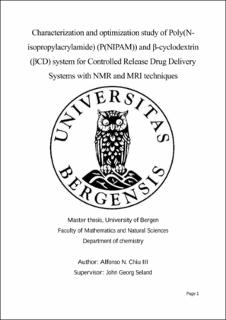Characterization and optimization study of Poly(N-isopropylacrylamide) (P(NIPAM)) and β-cyclodextrin (βCD) system for Controlled Release Drug Delivery Systems with NMR and MRI techniques
Master thesis
Permanent lenke
https://hdl.handle.net/11250/3014190Utgivelsesdato
2022-08-10Metadata
Vis full innførselSamlinger
- Master theses [85]
Sammendrag
This project is a direct continuation from my bachelor project that was based off Wisniewska,M (2017), where she investigated the changes in Poly(N-isopropylacrylamide) P(NIPAM) at the Volume Phase Transition (VPT) . The goal of the project was to expand the portfolio and characterization of P(NIPAM), particularly on how β-cyclodextrin (βCD) reacts as it goes through VPT both inside the hydrogel and outside the hydrogel. By using Magnetic Resonance Imaging (MRI), it allows us to monitor the changes of P(NIPAM) as it goes through the Lower Critical Solution Temperature (LCST), the Volume Phase Transition Temperature (VPTT), and 40 °C. Multi-Slice Multi-Echo (MSME) imaging was used to monitor the physical changes of the hydrogel with increasing temperature for comparison to spectral data using Magnetic Resonance Spectroscopy (MRS). Combining MRI with MRS allows for us to combine the macroscopic and microscopic picture of the βCD activity inside and outside the hydrogel. The changes of βCD in the polymer interior and exterior was monitored using STimulated Echo Acquisition Mode (STEAM), and the diffusion of βCD and water inside the hydrogel was recorded using MEshcher-GArwood Point RESolved Spectroscopy (MEGA-PRESS). The release of the βCD inside the hydrogel network was minimal until reaching VPTT, where the change in concentration sharply decreased due to the phase transition. As for the βCD change outside the hydrogel, the change was adherent to the shrinkage kinetics of P(NIPAM), showing delays in release due to restricted diffusion caused by the shrinkage of the P(NIPAM) after VPTT. For the self-diffusion data of the βCD, it was found that the βCD signals were loss using MEGA-PRESS after VPTT as a result of diffusion. The water self-diffusion values were also found to be decreasing consistently after a delay from 40°C.
